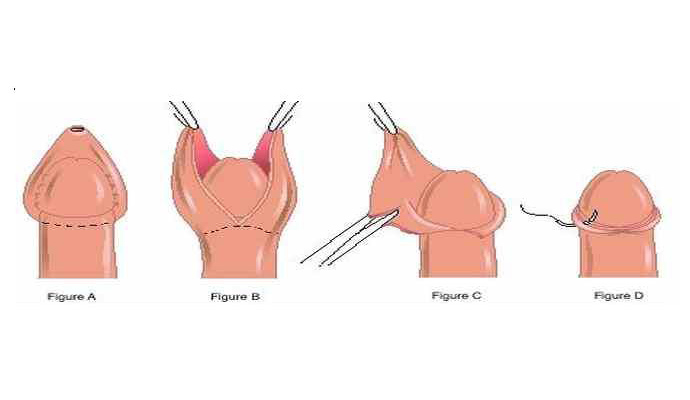Phimosis
Understanding Phimosis: Causes, Symptoms, and Treatment Options
Phimosis is a condition in which the foreskin of the penis cannot be retracted over the head (glans) of the penis. It is common in infants and young boys but can also affect adult men. While it may not cause significant problems in some cases, phimosis can lead to discomfort, pain, and other complications if left untreated. In this blog, we will explore the causes, symptoms, grades, and treatment options for phimosis, including why Surgiplus Hospital in Nagpur, led by Dr. Pitambar Masram, is the best choice for treatment.

What is Phimosis?
Phimosis is a medical condition where the foreskin of the penis is too tight to be pulled back over the glans (head of the penis). This condition can cause discomfort during urination, sexual activity, and can increase the risk of infections. Phimosis is often diagnosed in childhood, but it can also occur later in life due to various factors such as infection or trauma.
There are two types of phimosis:
- Physiological Phimosis: This is common in infants and young children and is usually not a cause for concern. In most cases, it resolves naturally as the child grows.
- Pathological Phimosis: This type of phimosis is more problematic and occurs due to scarring, infections, or other underlying conditions that cause the foreskin to become tight and difficult to retract.
How Phimosis Develops
Phimosis can develop in various ways:
- Congenital (From Birth): In many cases, phimosis is present at birth, where the foreskin is naturally tight and does not retract over the glans. In most boys, this condition resolves on its own as they age, typically by the age of 3-5 years.
- Acquired Phimosis: In adults, phimosis can develop as a result of infection, inflammation, or injury to the foreskin. Conditions such as balanitis (inflammation of the head of the penis), poor hygiene, or repeated infections can lead to scarring that makes the foreskin tighter and less flexible.
What Are the Grades of Phimosis?
Phimosis is graded based on the severity of the condition, which helps in determining the appropriate treatment plan. The grades are as follows:
- Grade 1 (Mild Phimosis): The foreskin is slightly tight but can still be retracted with some difficulty. There are no significant symptoms, and the condition may improve with proper care.
- Grade 2 (Moderate Phimosis): The foreskin can be retracted with more effort, but it might cause some pain or discomfort during retraction. Symptoms like difficulty urinating or painful erections may be present.
- Grade 3 (Severe Phimosis): The foreskin cannot be retracted at all. This grade often involves symptoms such as pain, swelling, and an increased risk of infection.
- Grade 4 (Complete Phimosis): The foreskin is tightly adhered to the glans, and retraction is impossible. In severe cases, this can lead to painful urination, infections, or paraphimosis (when the retracted foreskin cannot be returned to its normal position).
What Are the Symptoms of Phimosis?
The symptoms of phimosis can vary depending on the severity of the condition. Common signs include:
- Pain or discomfort when the foreskin is retracted or during sexual activity.
- Difficulty urinating or a slow, painful stream due to the tightness of the foreskin.
- Swelling or redness around the foreskin or glans.
- Increased risk of infections, such as balanitis (inflammation of the glans) or urinary tract infections (UTIs).
- Painful erections, where the foreskin is too tight to move or retract.
In severe cases, if the foreskin becomes trapped behind the glans, this can lead to paraphimosis, which is a medical emergency.
What Are the Causative Factors of Phimosis?
There are several factors that can lead to the development of phimosis:
- Congenital Factors: As mentioned earlier, some boys are born with tight foreskins that do not retract. This is often normal in early childhood.
- Infections: Recurrent infections like balanitis or posthitis (inflammation of the foreskin) can cause scarring and tightening of the foreskin.
- Poor Hygiene: If the area is not cleaned properly, bacteria and other microorganisms can accumulate, leading to infections and scarring of the foreskin.
- Trauma or Injury: Any injury or trauma to the foreskin, including harsh handling, can result in scarring and the development of phimosis.
- Medical Conditions: Conditions such as diabetes and eczema can predispose individuals to developing phimosis due to changes in the skin and immune system.
What Are the Different Treatment Modalities for Phimosis?
The treatment for phimosis depends on the severity of the condition. Here are the most common treatment options:
- Conservative Treatments (For Mild Cases)
- Topical Steroid Creams: These can be applied to the foreskin to help loosen it and allow for easier retraction. Steroid creams are commonly used for mild to moderate phimosis and can help avoid surgery in many cases.
- Gentle Stretching Exercises: Gradually stretching the foreskin over time can help reduce tightness and improve retraction. This should be done carefully to avoid injury.
- Surgical Treatment
- Circumcision: This is a surgical procedure in which the foreskin is entirely removed, resolving the problem of phimosis permanently. Circumcision is the most definitive treatment for severe or recurrent cases of phimosis.
- Preputioplasty: This is a less invasive option where the tight foreskin is surgically loosened without removing it completely.
- Dorsal Slit: A slit is made in the foreskin to relieve the tightness, though this is typically used for emergency situations or in cases of paraphimosis.

What is Circumcision?
Circumcision is the surgical removal of the foreskin, the fold of skin that covers the glans (head) of the penis. This is a definitive treatment for phimosis and is typically recommended for patients with severe or recurrent cases that do not respond to conservative treatments. Circumcision resolves the problem permanently by eliminating the tight foreskin, which prevents further infections, pain, and discomfort.
Why Stapler Circumcision is the Best Option
Stapler circumcision is a modern, minimally invasive surgical technique used to remove the foreskin. It is considered one of the best methods for circumcision because of its numerous advantages:
- Less Invasive: The procedure involves minimal cutting and stitching, reducing the risk of complications.
- Faster Recovery: Patients experience less pain and faster healing compared to traditional circumcision methods.
- Minimal Scarring: The use of a stapler ensures a clean and precise procedure, resulting in minimal scarring.
- Shorter Procedure Time: Stapler circumcision is quicker, typically taking only about 10-15 minutes, making it an ideal choice for both adults and children.
Overall, stapler circumcision provides a safer, more efficient, and less painful option for resolving phimosis.
Why Surgiplus Hospital, Nagpur, is the Best Option for Phimosis Treatment
Surgiplus Hospital in Nagpur is a premier healthcare facility offering high-quality care for various medical conditions, including phimosis. Here’s why it’s the best choice for phimosis treatment:
- State-of-the-Art Technology: The hospital uses advanced diagnostic tools and modern surgical techniques like stapler circumcision to ensure the best results.
- Comprehensive Care: Surgiplus offers a holistic approach to treatment, from diagnosis to post-surgery care, ensuring that patients receive complete support throughout their recovery journey.
- Experienced Surgeons: The hospital has a team of skilled surgeons specializing in urology and circumcision procedures, ensuring optimal care for every patient.
Why Dr. Pitambar Masram is the Best Surgeon for Phimosis Treatment in Nagpur
Dr. Pitambar Masram is a renowned surgeon in Nagpur with over 21 years of experience in treating phimosis and other urological conditions. Here’s why Dr. Masram is considered one of the best in Nagpur:
- Expert in Circumcision: Dr. Masram is highly skilled in performing circumcision, including the advanced stapler circumcision technique, ensuring quick recovery and minimal complications.
- Fellowship in Coloproctology: With a Fellowship in Coloproctology, Dr. Masram has advanced expertise in managing various anorectal and urological conditions, including phimosis.
- Personalized Approach: Dr. Masram focuses on providing individualized treatment plans, ensuring that each patient receives the best possible care tailored to their needs.
- Proven Success: With a vast experience and numerous successful surgeries, Dr. Masram has gained the trust of his patients, making him one of the top surgeons in Nagpur.
Conclusion
Phimosis can be a troublesome and uncomfortable condition, but with the right treatment, it is entirely manageable. Whether you require conservative treatments like steroid creams or more definitive surgical options such as circumcision, Surgiplus Hospital in Nagpur, under the expertise of Dr. Pitambar Masram, provides the best care for managing phimosis. With his extensive experience and advanced techniques, Dr. Masram ensures safe and effective treatment for his patients, helping them regain comfort and quality of life.
If you’re experiencing symptoms of phimosis or have concerns, don’t hesitate to reach out to Surgiplus Hospital and schedule a consultation with Dr. Pitambar Masram for a comprehensive assessment and treatment plan.
